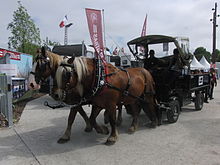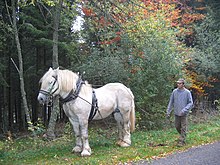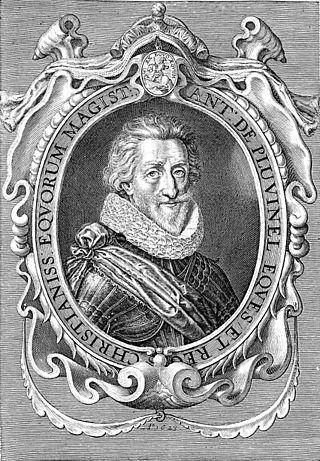
Antoine de Pluvinel was the first of the French riding masters, and has had great influence on modern dressage. He wrote L’Instruction du Roy en l’exercice de monter à cheval, was tutor to King Louis XIII, and is credited with the invention of using two pillars, as well as using shoulder-in to increase suppleness.

Fantasia is a traditional exhibition of horsemanship in the Maghreb performed during cultural festivals and for Maghrebi wedding celebrations. It is present in Algeria, Libya, Mali, Mauritania, Morocco, Niger and Tunisia. It is attested in the ancient Numidian times during which it was practiced by the Numidian cavalry. Historian Carlos Henriques Pereira stated that the North African fantasia also called barud is a modern watered down version of a Numidian military technique.

The Anglo-Norman horse is a warmblood horse breed developed in Lower Normandy in northern France. A major center of horse breeding, the area had numerous regional types that were bred to one another and then crossed with Thoroughbreds to form the Anglo-Norman. Various body types developed within the Anglo-Norman breed, two of which were split off to form the Norman Cob and French Trotter. The remaining types were eventually standardized, although there remained some criticism of the "hybrid" nature of the breed's conformation. However, it is successful as an international sport horse, especially in the sport of show jumping. The Anglo-Norman also contributed to the development of several other breeds in Europe and Asia.

The Charolais or Charollais is an extinct breed of warmblood horse from the Charolais, the country lying around the town of Charolles, now in the Saône-et-Loire département of Burgundy, in eastern central France. Like other French warmbloods, it was the result of crossing local agricultural horses with the Thoroughbred, and was known by the name of the region without ever having a specific stud-book. Like other French warmbloods including the Angevin, the Charentais, the Cheval Limousin and the Vendéen, it was fused with the Anglo-Normand in 1958 in order to create the national warmblood stud-book, the Selle français. It was originally used as a multi-purpose horse for riding, driving, and agriculture. During the late 19th century, additional Thoroughbred blood was added and a new type emerged that was principally used as a light cavalry mount. It was also used for dressage and show jumping.

The Henson Horse, or Cheval de Henson, is a modern horse breed from northeast France. It was created by the selective breeding of light saddle horses with the smaller, heavier Norwegian Fjord horse to create small horses suitable for the equestrian vacation industry. The breeders' association, Association du Cheval Henson, was formed in 1983. In 1995 the studbook was closed to horses not born from Henson parents, and in 2003 the breed was officially recognised by the French government agencies for horse breeding. A hardy breed of horse, each winter the broodmares and youngstock from several breeders are let loose together to graze freely in the wetland reserves in France.

The Bidet was a type of small horse from France, now extinct. It was a landrace developed principally in the area around Brittany, Morvan, Auvergne, Poitou, and Burgundy. It stood about 110–135 centimetres at the withers. Two distinct groups are documented, which were bred in a semi-feral state.

Marine Oussedik, born on May 20, 1967, is a painter, sculptor and an illustrator specialized in horses. In 1990, she graduated from ESAG Penninghen, the Higher College of Graphic Arts, and started exhibiting in Parisian galleries the following year. Immediately afterwards she was commissioned paintings by the Living Museum of the Horse in Chantilly to be permanently displayed in two rooms. At the same time she published a book, Les chevaux d'encre. Many art books would follow including Les chevaux du Sahara in 1998, Les chevaux du vent in 2002 and Les chevaux de rois in 2003. She would be rewarded by Prix Pégase for those last two books which testify to her passion for illustrations of all kind of horses, Arabians being her favorite. In 2014, she illustrated an art book dedicated to classical French riding with texts by Guillaume Henry.
The Cheval du Morvan, also known as the Morvandiau, Morvandain or Morvandelle, is an extinct French horse breed from the Morvan massif in Burgundy, for which it is named. Horses were bred in the Morvan from before the French Revolution, both as saddle-horses for fox-hunting and as cavalry mounts, and for draught use. They were of small to medium height and known for their strength and tenacity. The Cheval du Morvan became extinct with the advent of industrialisation and improved transportation in the nineteenth century. As a draught horse it was replaced by the Nivernais and Comtois breeds, and as a saddle-horse by the Thoroughbred.

Pierre-Nicolas Tourgueneff was a French animalier sculptor and painter who worked in the late 19th century and early 20th century. He was a cousin of the writer Ivan Sergeyevich Turgenev. He began to exhibit his sculptures at the Salon in 1880 and continued to do so throughout his career.
Royal Moroccan Equestrian Federation is the governing body of equestrian sports located at the Dar Es Salam facility in Rabat, Morocco. It has been an affiliated member of the International Equestrian Federation (FEI) since 1958. The federation oversees equestrian sporting which includes horse racing, dressage, jumping, and the traditional equestrian sport of fantasia. Started in 1956, the federation was created under the Moroccan Ministry for Youth and Sports.
Laurence Bougault, was a French writer and academic. She was also well known as a long-distance adventurer on horseback.

Haguard horse, also known as the Hague pony or bidet de la Hague, is a breed of bidet horse native to the natural region of La Hague, in the Manche in Normandy.
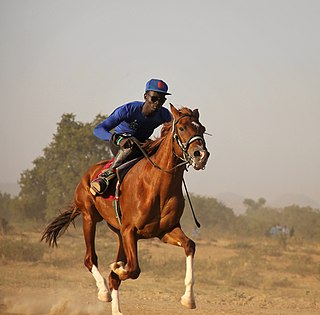
The history of horses in Cameroon is linked above all to the traditional presence of this animal in the northern regions of the country, around Lake Chad from the 16th century, then in Adamawa, as well as in the Garoua and Maroua regions. Traditional equestrian practices in Cameroon, such as horse parades and horse dances, have more recently been joined by equestrian activities, under the influence of Western expatriates and investors, notably in Yaoundé since the 1990s. The main use of horses in Cameroon is in agriculture and transport fields.

The Cauchois, or Norman bidet, is a breed of heavy draft horse native to the Pays de Caux, on the coast of the former Haute-Normandie region of France. Renowned for its ability to move at a high pace, it was much sought-after in the seventeenth and eighteenth centuries. Although it was most often harnessed to heavy loads, such as the Compagnie Générale des Omnibus stagecoaches, it was also sometimes ridden by Cauchois peasants to market. They were exported to many parts of France.

The Barraquand horse is a French mountain horse breed. It is the result of an ancient selection process in the Vercors Massif, and it may have originated from a small herd of animals selected by religious communities, notably those established in the Léoncel abbey. It takes its name from the Barraquand family, who developed their breeding from the late 19th century to the 1950s, thanks to the practice of transhumance. Considered lost after the bankruptcy of the original Barraquand breeding operation and the sale of part of their land in 1963, the breed has been reconstituted since the 1990s, thanks to the initiative of several breeders and local institutions, in particular the Barraquand family, the Vercors Regional Natural Park and the Annecy National Stud.
Equine ethics is a field of ethical and philosophical reflection around the horse, aimed at questioning human behavior towards this animal, and modifying it in the event of unethical practices. It includes questions about breeding, keeping, use and end of life, in close relation to the notion of respect and well-being of the horse. In particular, this debate crystallizes around sensitive subjects such as the slaughter of horses, the consumption of their meat, their legal status, zoophilia, doping in sport, their possible retirement after exploitation by humans, the choice of euthanasia and the destination of the animal's body after death. Societal demands include recognition of the horse as a pet, and greater consideration for its sensitivity.
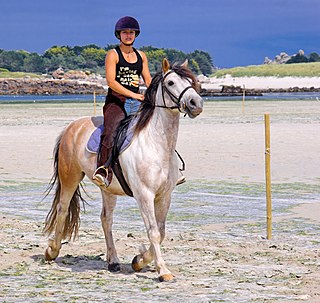
Leisure horses are intended for pleasure riding, and in particular for trail riding by private individuals. Difficult to define, it is above all an animal endowed with particular qualities, rather than a precise breed. It must be versatile and calm in character, with a willing and courageous mind. As early as the 1970s, breeders such as those of the Swiss Freiberger or Franches-Montagnes were breeding animals for this then-new use. The market for leisure horses is now buoyant. France has created "leisure qualifications" for this purpose.

Horses in Greece are a symbol of prestige, associated as far back as antiquity with military cavalry and chariot races on racings. Horses are also very present in Greek mythology.
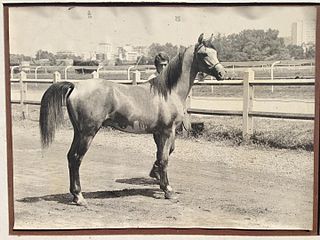
Persik, born on 1 April 1969 and died on 24 August 2001, was a gray-coated Arabian horse who was the leading sire in the equestrian discipline of endurance from 1975 until his death in 2001. His eclectic origins include Polish and Russian bloodlines, as well as French and English, in particular the famous Skowronek. Purchased in 1973 from the Tersk stud farm, Persik was imported to France by Jean Cougul, a breeder from Vigoulet-Auzil, then bought by the Cévennes National Park with the aim of breeding horses suitable for trail riding. In 1975, Persik won the first edition of a well-known endurance race, the 130 km de Florac.

The Haras National de Lamballe is one of five equestrian centers in the French region of Brittany. Originally, it was a depot for royal stallions, created in the autumn of 1783 in the sole stable of a barracks in the town of Lamballe. Abolished in 1790, briefly recreated in 1825, this national stud took on its definitive form in 1842, when it was given the task of making breeding stallions available to the owners of the 70,000 broodmares in its district. Numerous extensions led to the construction of eleven new stables until the beginning of the 20th century, housing up to 350 stallions of all breeds. The National Stud played a major role in the development of the Norfolk-Breton breed, the future Breton horse, by importing Norfolk Trotter stallions from England. It was also responsible for the success of the half-Ardennes stallion Naous, one of the founding stallions of the Breton horse breed.


